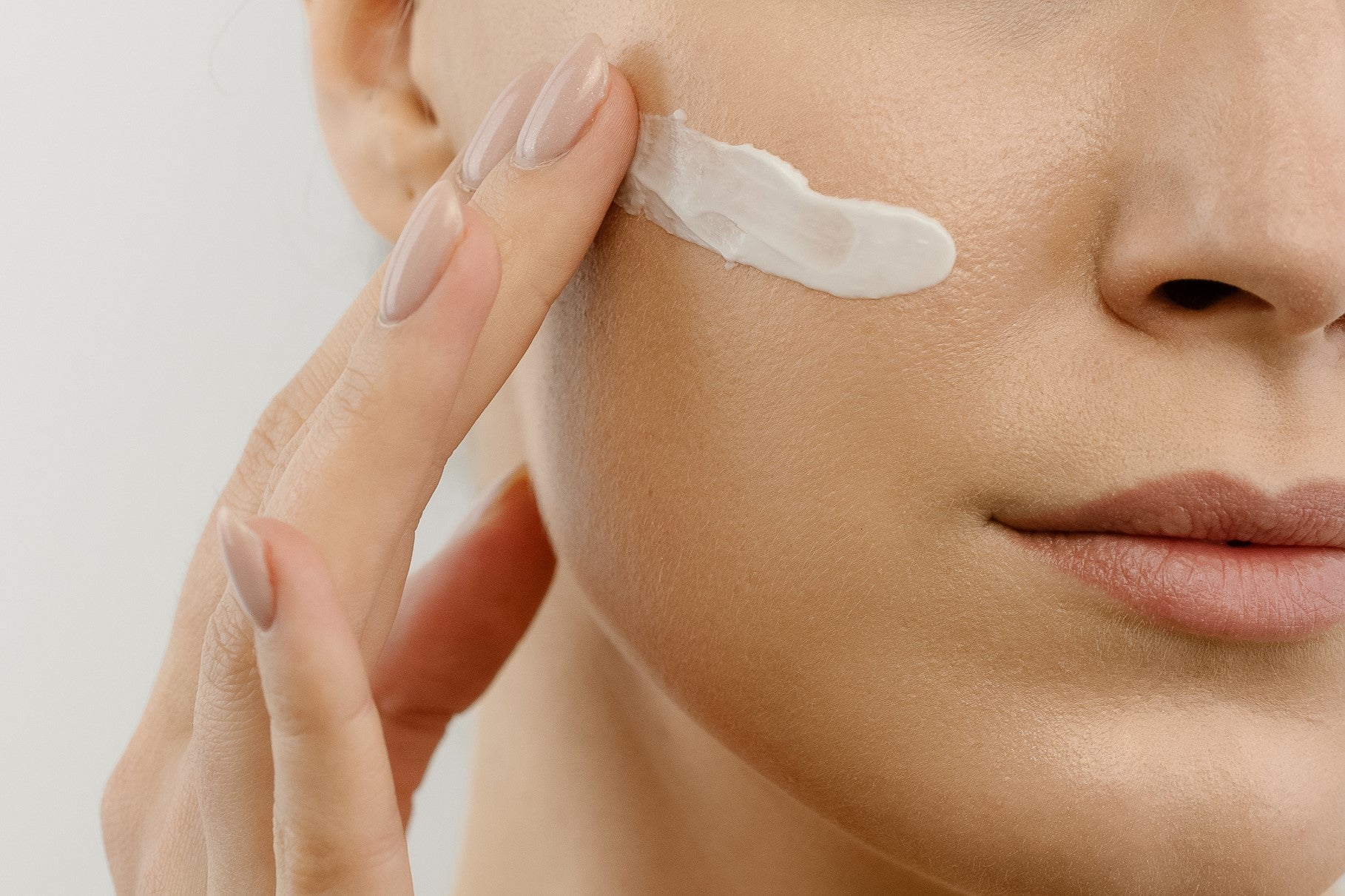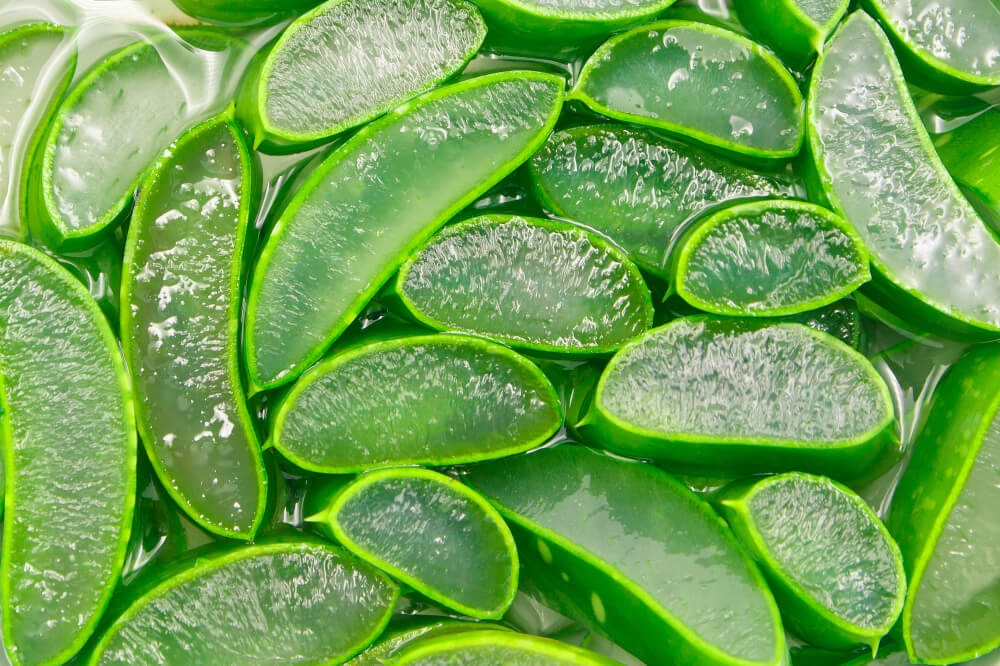In zahlreichen kosmetischen Produkten ist Hyaluronsäure enthalten. Aber was verbirgt sich dahinter und wie wirkt der Inhaltsstoff auf die Haut? Bei einem schwachen Bindegewebe, trockener oder zu Fältchen neigender Haut, kann Hyaluron helfen, die Haut bei der Regeneration zu unterstützen und ihr mehr Frische zu schenken.
Was genau ist Hyaluronsäure eigentlich?
Bei Hyaluronsäure handelt es sich um ein körpereigenes Produkt, das zum Mehrfachzucker gehört. Du trägst in Deinem Körper selbst viel Hyaluronsäure. Zu finden ist sie beispielsweise in den Knochen oder auch in der Haut, sie wirkt als Gelenkflüssigkeit und tritt in den Knorpeln auf. Auch der Glaskörper im Auge enthält Hyaluron. Tatsächlich handelt es sich sogar um einen Hauptbestandteil des Bindegewebes. Hier hat Hyaluron eine auffüllende und stützende Wirkung, da es einen wasserbindenden Effekt mitbringt. In der Medizin wird auf Hyaluronsäure zurückgegriffen, um die Auswirkungen von Arthrose auf den Körper zu reduzieren.
Eine wichtige Eigenschaft der Hyaluronsäure ist es, Flüssigkeit zu binden. Bis zu sechs Liter Wasser kann durch ein Gramm der Säure gebunden werden. Wenn es zu einer Verbindung zwischen der Hyaluronsäure und Wasser kommt, entsteht ein Material, das eine gelartige Konsistenz hat. Dies sorgt dafür, dass Hyaluron den Effekt eines Schmiermittels im Körper hat. Dein Bindegewebe benötigt, für eine ausreichende Elastizität, viel Flüssigkeit. Das wasserbindende Hyaluron als Hauptbestandteil, hat also eine umfassende Aufgabe. Ein schwaches Bindegewebe deutet unter anderem darauf hin, dass nicht ausreichend Hyaluron enthalten ist.
Allerdings ist es nicht nur Hyaluronsäure, die in Deinem Körper als Gelenkschmiere und arbeitet oder dafür sorgt, dass die Gelenke sich geschmeidig bewegen können. Tatsächlich wird von Synovia gesprochen. Bei Synovia handelt es sich um eine Kombination aus Hyaluron, Lipiden, Proteinen und Hyaluron. Das Schmiermittel sorgt dafür, dass Knorpel und Gelenke gut versorgt sind, nicht aneinander reiben und es nicht zu Entzündungen kommt. Daher wird Synovia auch als Gelenkschmiere oder Gelenkflüssigkeit bezeichnet.
Mit zunehmendem Alter ist der Körper weniger in der Lage, Hyaluron zu bilden. Die Anzeichen dafür sind unterschiedlich. Möglicherweise beginnt es, in den Gelenken ein wenig zu knacken. Die Haut bekommt Falten und verliert an Elastizität. Das ist ein normaler Effekt, den Du jedoch nicht hinnehmen müssen.
Wichtig: Rein wissenschaftlich gesehen ist die Bezeichnung gar nicht „Hyaluronsäure“, sondern „Hyaluronan“. Nach wie vor setzen sich aber die Begriffe „Hyaluron“ und auch „Hyaluronsäure“ durch. Der Begriff steht immer für denselben Inhaltsstoff.
Unterschiede zwischen kurzkettiger und langkettiger Hyaluronsäure
Um noch besser nachvollziehen zu können, wie Hyaluron in Kosmetik wirkt, ist es gut zu wissen, dass es die Hyaluronsäure in verschiedenen Größen gibt und sie so auch unterschiedlich auf den Körper wirken.
Im Körper ist Hyaluron meist als langkettige Hyaluronsäure zu finden. Die Molekülmasse ist hier sehr hoch. Allerdings haben Untersuchungen gezeigt, dass die Hautpflege eher von kurzkettiger Hyaluronsäure profitiert. Die Molekülmasse ist bei dieser geringer. Dadurch kann sie die Hautbarriere durchbrechen und tief in die Haut eindringen.
Verarbeitet werden kann also einmal die niedermolekulare Hyaluronsäure und die hochmolekulare Hyaluronsäure. Liegen bei dem Inhaltsstoff kleine Hyaluronketten vor, dringt der Inhaltsstoff deutlich tiefer in die Haut ein. Dadurch wirkt er effektiv.
Bei kosmetischen Produkten wird auf die Verwendung von Hyaluronsäure durch die Bezeichnung „Sodium Hyaluronate“ hingewiesen. Es ist nicht erkennbar, ob es sich um langkettige oder um kurzkettige Hyaluronsäure handelt.

Wie die einzelnen Varianten auf die Haut wirken
Doch wie findest Du heraus, ob Du Dich lieber für Produkte mit einer langkettigen oder einer kurzkettigen Hyaluronsäure entscheiden sollten? Das kommt ganz darauf an, welche Wirkung Du Dir von dem kosmetischen Produkt erhoffst.
Die hochmolekulare Hyaluronsäure als Feuchtigkeits-Lieferant
Hochmolekulare Hyaluronsäure zieht zwar nicht optimal in die Haut ein. Sie hat aber dennoch eine wichtige Funktion. Werden Produkte mit hochmolekularer Säure auf die Haut aufgetragen, kommt es zu einer Reaktion. In Deiner Haut befindet sich Keratin. Zusammen mit der Hyaluronsäure bildet das Keratin eine Verbindung und legt sich auf die Haut.
Dieser Film, der sich nun bildet, gibt Deiner Haut sowohl Elastizität als auch Feuchtigkeit. Die kurzfristige Wirkung beruhigt das Hautbild und bringt eine wohltuende Wirkung mit. Zudem wirkt die Hyaluronsäure entzündungshemmend. Leidest Du also unter Rötungen der Haut oder kleinen Entzündungen, sind kosmetische Produkte mit hochmolekularer Hyaluronsäure eine Empfehlung.
Die niedermolekulare Hyaluronsäure als Booster für die Haut
Durch die Hautbarriere dringt niedermolekulare Hyaluronsäure deutlich besser hindurch. Sie unterstützt die Bindung von Wasser in der Haut und versorgt diese mit zusätzlicher Feuchtigkeit. Dadurch wirkt die Haut, bei einer regelmäßigen Anwendung, straffer und praller. Erste kleine Fältchen, die sich bei Deiner Haut zeigen, werden reduziert.
Mit der Anwendung von niedermolekularer Hyaluronsäure wird die Haut nicht nur mit Feuchtigkeit versorgt. Zusätzlich dazu wird diese Feuchtigkeit auch noch in der Haut gespeichert. Das heißt, die Wirkung ist besonders nachhaltig.
Du leidest unter sehr trockener Haut? Deine Haut wirkt weniger straff und spannt? Du merkst, dass Feuchtigkeit fehlt? In diesem Fall sind die kurzkettigen Säuren eine große Hilfe.
Eine Besonderheit: Die Oligo-Hyaluronsäure
Als eine außergewöhnliche Variante gibt es noch die Oligo-Hyaluronsäure. Diese Ausführung gilt als extrem-kurzkettig. Dadurch ist sie noch mehr in der Lage, die Hautbarrieren zu durchdringen. Bisher ist die Oligo-Hyaluronsäure allerdings nur in sehr wenigen Produkten zu finden, da sie als besonders erlesen gilt und nur schwer zu gewinnen ist.
Ein Blick auf die Konzentration bei der Wirkung von Hyaluronsäure
Inwieweit wirkt sich die Konzentration von Hyaluron in einem Produkt eigentlich auf die Wirkung der Hyaluronsäure aus? Hierfür ist ein Blick auf die jeweiligen Produkte zu empfehlen.
Meist erfolgt die Angabe der Konzentration mit Begriffen, wie 10 %. Diese Angabe bezieht sich jedoch vor allem auf das Gemisch, das aus Wasser und aus Hyaluronsäure besteht. Ein hochwertiges Serum sollte eine Konzentration von 1 % vorweisen. Diese 1 % stehen für eine reine Hyaluronsäure.
Je höher der Gehalt, umso unangenehmer fühlt sich der Wirkstoff auf der Haut an. Das Problem dabei ist, dass zwar die Hyaluronsäure Wirkung einsetzt, die Haut aber sehr klebrig wird. Dies ist unter anderem auch dann der Fall, wenn langkettige Hyaluronsäure eingesetzt wird.
Anwendungsgebiete für Hyaluronsäure
Die Einsatzbereiche in der Kosmetik für Hyaluronan sind vielseitig. Oft sind jedoch nur die Anwendungsbereiche gegen Falten und trockene Haut bekannt. Für umfassende Informationen dazu, wo sich die Hyaluronsäure Wirkung eigentlich entfaltet, nehmen wir die einzelnen Bereiche unter die Lupe:
- Falten
Es gibt viele Versprechen im Kampf gegen die Falten, doch nur wenige Wirkstoffe, die auch nachweislich einen Effekt auf die Haut haben. Einer dieser Wirkstoffe ist Hyaluronsäure. Es gibt verschiedene Studien, die sich mit der Anti-Falten-Wirkung beschäftigen und diese auch schon bestätigt haben.
Der Effekt besteht in erster Linie darin, dass der Wirkstoff viel Feuchtigkeit spendet und die Haut so optisch aufpolstert. Zusätzlich dazu solltest Du weitere Vorkehrungen treffen.
Deine Haut benötigt täglich einen guten UVA-Schutz, damit die UV-Strahlung die Hautalterung nicht vorantreiben kann. Verhindere Stress und nutz Produkte, die Deine Haut mit Vitamin C und Vitamin E versorgen.
- Augenpflege
Gerade die Haut rund um die Augen ist sehr empfindlich. An dieser Stelle ist Deine Haut dünn und anfällig für Störungen der Barriere. Damit diese gar nicht erst eintreten, solltest Du eine Augencreme mit Hyaluronsäure verwenden.
Die Haut rund um die Augen benötigt Wirkstoffe, die für eine Stärkung der Barriere sorgen. Dazu gehören, neben der Hyaluronsäure, auch Substanzen, die einen hohen Anteil an Lipiden haben. Als sinnvoll erwiesen hat sich beispielsweise Squalan.
- Trockene Haut
Nicht zu unterschätzen ist die Wirkung von Hyaluronsäure auf trockene Haut. Als Feuchtigkeitsspender ist sie hervorragend geeignet und kann auch kurzfristig für Hilfe sorgen. Beachte jedoch, dass Deine Haut Feuchtigkeit nur dann speichern kann, wenn sie gesund ist und eine stabile Barriere hat. Baue daher auch die Barriere Deiner Haut auf und stärke diese. Das funktioniert unter anderem mit Wirkstoffen, wie Ceramiden.

Unsere Seren mit Hyaluronsäure richtig anwenden
Bei einem Serum handelt es sich um eine intensive Pflege für die Haut. Unsere Haut ist den ganzen Tag verschiedenen Einflüssen ausgesetzt. Dazu kommt der natürliche Alterungsprozess, der ebenfalls seine Wirkung zeigt. Eine intensive Pflege ist daher unbedingt zu empfehlen.
Deine täglichen Routinen haben einen großen Einfluss darauf, wie sich Deine Haut entwickelt und wie sie aussieht. Baue ein Hyaluron-Serum ein, so erhält Deine Haut ein hohes Maß an Wirkstoffen.
Ein Serum hat eine sehr leichte Konsistenz. Dies ist ein Vorteil, da sie auf diese Weise tiefer in die Haut eindringen können. Das ist auch wichtig, damit die Wirkstoffe in die Haut eindringen und dort ihre Wirkung entfalten können.
Die Pflegemoleküle, die in Seren enthalten sind, sind winzig. Ebenso wie bei der Hyaluronsäure selbst, ist es auch hier der Fall, dass kleine Moleküle leichter durch die Hautbarriere eindringen können.
Dadurch sind Seren hervorragend geeignet, für:
- trockene Haut
- Haut mit Pigmentflecken
- Haut mit Pickeln
- erste Hautfalten
Für wen ist ein Serum geeignet?
Experten geben den Hinweis, dass jeder Mensch ein Serum verwenden sollte. Das gilt sowohl für Damen als auch für Herren. Dabei ist jedoch zu berücksichtigen, dass jede Haut andere Ansprüche hat. Hier sind wir wieder beim Hinweis auf die verschiedenen Arten der Hyaluronsäure.
Viele Seren sind für alle Hauttypen geeignet. Es gibt aber auch Produkte, deren Zusammensetzung so konzipiert wurde, dass die Behandlung vorwiegend den Fokus auf ein bestimmtes Problem mit der Haut liegt.
Ein Serum mit Hyaluronsäure und Aloe Vera hat einen beruhigenden und kühlenden sowie erfrischenden Effekt. Gleichzeitig entfaltet die Wirkung von Hyaluron an ein Sofortlifting, das schon nach wenigen Anwendungen zu sehen ist.
Eine Unterstützung der Kollagenproduktion hilft Deiner Haut dabei, sich selbst helfen zu können und den Feuchtigkeitsgehalt der Haut wieder ins Gleichgewicht zu bringen.
So wenden Du ein Serum korrekt an
Damit die Hyaluronsäure ihre Wirkung entfalten kann, ist eine korrekte Anwendung von Deinem Serum wichtig. Die folgenden Schritte sind hier zu empfehlen:
- Reinige Dein Gesicht mit einem passenden Präparat und befreie es, von Make-up sowie Verschmutzungen und abgestorbenen Hautschuppen. Du kannst auch ein Peeling verwenden, dadurch wird die Haut deutlich aufnahmefähiger.
- Sorge dafür, dass Deine Haut komplett abgetrocknet ist.
- Verteile nun das Serum. Gib aber nur wenig davon auf die Haut. Es reicht aus, wenn auf Wangen, Hals und Stirn jeweils ein Tropfen aufgetragen wird.
- Nimm Dir jetzt Zeit und verteile das Serum. Nutze dafür die Finger und arbeite die Wirkstoffe mit kreisenden Bewegungen in Deine Haut ein.
- Trage jetzt noch die Pflegecreme auf, die zu Deiner Routine gehört.
Wie häufig und wann Du ein Serum mit Hyaluronsäure einsetzt, hängt ganz vom Präparat und den individuellen Bedürfnissen Deiner Haut ab.
Damit sich Deine Haut optimal regenerieren und die enthaltenen Wirkstoffe aufnehmen und verarbeiten kann, ist es empfehlenswert, das Serum am Abend aufzutragen. Aber auch am Morgen kann ein Serum eingesetzt werden.
Die Unterspritzung mit Hyaluron
In der Kosmetik wird Hyaluronsäure für ein verbessertes Hautbild nicht nur im Serum oder in Nahrungsergänzungsmitteln eingesetzt. Es gibt auch Präparate, die für eine Faltenbehandlung in Form einer Unterspritzung verwendet werden.
Die Faltenunterspritzung soll dafür sorgen, dass das Hautbild straffer wirkt. Auch hier kommt die wasserbindende Wirkung zum Einsatz.
Eine Unterspritzung mit Hyaluron kann in verschiedenen Bereichen des Gesichts durchgeführt. Oft wird sich aber vor allem für eine Faltenunterspritzung der Nasolabialfalte entschieden. Sie beginnt an der Nase und reicht bis hin zum Kinn.
Der Effekt selbst tritt nach der Faltenbehandlung aber nicht direkt ein. Abhängig davon, wie Deine Hautschichten reagieren, kann sich der Effekt auch erst nach zwei Wochen einstellen.
Grundsätzlich wichtig ist, dass eine Faltenbehandlung durch Unterspritzung nur von Ärzten durchgeführt wird, die eine spezielle Ausbildung durchlaufen haben.
Wie sinnvoll sind Nahrungsergänzungsmittel mit Hyaluronsäure?
Hyaluronsäure von innen wirken lassen? Auch wenn Du in Deinem Körper in vielen Bereichen, wie dem Glaskörper im Auge und den Knorpeln, Hyaluron haben, bedeutet dies nicht, dass es noch besser wirkt, wenn Präparate als Nahrungsergänzungsmittel eingenommen werden.
Ein großes Problem bei Nahrungsergänzungsmitteln ist, dass die Hyaluronsäure im Körper zwar verarbeitet wird, die einzelnen Hautschichten aber nicht erreicht und daher hier auch keine Wirkung entfalten kann. Daher ist es wirkungsvoller, wenn Du für geschmeidige Haut, die Hyaluronsäure auf die Haut aufträgst. So kann das Hautbild direkt profitieren.
Was ist der Unterschied zwischen Kollagen und Hyaluronsäure?
Wenn es um die Hautfeuchtigkeit und die Spannkraft von Deinem Hautbild geht, wirst Du sowohl den Begriff „Kollagen“ als auch Hyaluron hören. Aber wo liegt hier eigentlich der Unterschied?
Kollagen ist ein sogenanntes Strukturprotein, das von Deinem Körper hergestellt wird und sich in Knorpeln, Zähnen, Knochen und in der Haut befindet. In der Haut hat es die Aufgabe, für Spannkraft zu sorgen. Gerade wenn Du noch sehr jung bist, hat Deine Haut eine hohe Spannkraft dank eines hohen Anteils an Kollagen. Die Produktion von Kollagen lässt in Deinem Körper allerdings mit zunehmendem Alter nach. Das ist eine Gemeinsamkeit zur Produktion von Hyaluron.
Wusstest Du, dass sogar die Wundheilung im Alter länger dauern kann?
Kosmetische Produkte enthalten kein Kollagen, sondern Wirkstoffe, die Deine Haut bei der Herstellung von Kollagen unterstützen. Wendest Du die Produkte regelmäßig an, kann sich dies positiv auf Dein Hautbild auswirken.
Kollagen bringt einige Vorteile mit:
- Es stabilisiert die Haut und erhält ihre Spannkraft.
- Kollagen lässt Deine Haut prall und glatt sowie strahlend wirken.
- Deine Haut bleibt elastisch.
Hyaluronsäure im Vergleich zu Kollagen
Auch Hyaluronsäure wird im Körper hergestellt und hat einen Effekt im Kampf gegen die Hautalterung. Hyaluron befindet sich in Gelenken, Knorpeln und der Haut – respektive direkt im Bindegewebe. Es ist der Hauptbestandteil des Bindegewebes. Ohne Hyaluron könnten die Zellen weder Flüssigkeit noch Nährstoffe austauschen.
Wird über Produkte Hyaluron zugeführt, dann kommt hier auch tatsächlich die Hyaluronsäure zum Einsatz. Sie versorgt die Haut mit Feuchtigkeit und sorgt dafür, dass diese Feuchtigkeit auch länger im Bindegewebe gespeichert werden kann. Die Hat wirkt voller und glatter. Gerade sehr trockene Haut profitiert, da diese ein besonderes Maß an Feuchtigkeit benötigt.
Hyaluron oder Kollagen – was wirkt besser als Pflege für die Haut?
Aber welcher der beiden Wirkstoffe hat denn nun einen besseren Effekt auf die Haut? Das lässt sich so nicht klar sagen. Daher empfehlen Experten, nach einem Präparat zu schauen, das mit Hyaluron angereichert ist, gleichzeitig aber auch die Herstellung von Kollagen im Körper unterstützt.
Nicht immer lassen sich Präparate finden, wo wirklich beides enthalten ist. Daher kannst Du auf eine Kombination aus mehreren Produkten zurückgreifen.
Wichtig ist es, dass Du auf die Reaktionen Deiner Haut achtest. Normalerweise ist Hyaluron sehr gut verträglich und hat keine Nebenwirkungen. Allerdings wird es oft in Kombination mit anderen Wirkstoffen eingesetzt, um die Wirkung von Hyaluronsäure zu unterstützen. Hier kann es sein, dass Deine Haut reagiert.
Schenke Deiner Haut Aufmerksamkeit
Deine Haut erlebt jeden Tag viel und arbeitet daher stets auf Hochtouren. Sie benötigt daher Aufmerksamkeit. Schenke Deiner Haut diese Aufmerksamkeit durch hochwertige Produkte für die Pflege, über die Du der Haut Nährstoffe hinzuführen und sie endlich wieder zum Strahlen bringen kannst.



